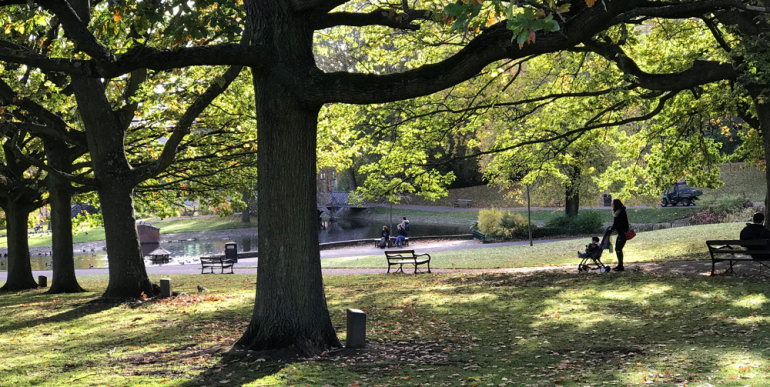Debating the future of urban parks
Dr Nicola Dempsey

I recently co-convened The Great Outdoors exhibition in the Winter Gardens, Sheffield with the Sheffield Institute of Policy Studies (Sheffield Hallam University), Drink Wise: Age Well and Sheffield City Council (Parks & Countryside). As part of this I hosted a debate on the future of urban parks with Hallam colleagues Jill Dickinson and Will Easdon.
Our four speakers were Councillor Mary Lea (Cabinet Member for Culture, Parks and Leisure, Sheffield City Council), Sue France (Green Estate which is custodian of Manor Fields Park), Peter Neal (landscape architect and environmental planner), Andy Jackson (Heeley Trust which is custodian of Heeley People’s Park). The debate was chaired by Dr Julian Dobson (Department of Landscape Architecture).
This is the first of two blogs sharing some of the debate…
What is the future of urban parks – what should parks be and how can they be better?
PN: there are lessons from history, from the great Victorian parks, particularly in northern industrial cities – parks can do everything for everyone. Parks must be for people and are a central tool to social building & social opportunity in terms of social cohesion and the social life of a city driving smart growth, development and helping our collective response to climate change mitigation.
AJ: we need an ongoing and sustained income. The park is dynamic and changes, just as the people living around the park change. Our parks need to be beautiful and safe, vandalism must be dealt with immediately and litter cleared. The challenge is that while capital is difficult to achieve, securing revenue funding is almost impossible.
SF: we need a future with the ability and freedom to do long-term management – a future with partnership and relationships to be built on. Working locally in partnerships leads to some really good work and activity in parks which is directly related to how well respected parks are. We need to cherish the assets we have. There will be over 1000 new homes in Manor & Castle which will mean changing dynamics of the area and new people moving in. We therefore need to plan for the beautiful places and not just the good enough spaces. And a 4-degree change in temperature in Sheffield will mean flooding, fires and lots more people outdoors. This is going to dynamically change our places and the need to design for long-term resilience.
ML: our parks are crucial for our health and wellbeing. Parks have their part to play in how people live with long-term health problems. Parks are also places for social cohesion: parks are the places where people can join together. Parks are really good for the economy because people are attracted to cities which look after their parks and green spaces.
Who are the best people to look after the parks?
ML: the council is the accountable custodian of our parks.
SF: while the council has a responsibility to look after our parks, there are other custodians looking after green spaces. Our civic assets are a civic duty – within any local council, there should be custodians. The best custodians are passionate about them and that passion is needed in the council. Accountability for providing that civic duty is important. As long as there is partnership, and proper arrangements around accountability, lots of different organisations can help in the custodianship of parks.
AJ: I am really worried about the future of our parks. We need to continue having this debate about parks well into the future. Our responses to date to parks have been traditional and we need to think and act differently. The scale of the challenge is enormous. In other towns and cities where I’ve been to advise, staff are worried about their jobs, about closing parks, about how to keep their kit going. They were once proud and motivated custodians but the slow cutting away of the budgets means that those custodians are disappearing. An overall sense of civic pride is required – we need the fabric of green space in our cities. We need more and more resources to manage this. How we use our resources could be done really differently and could engage communities more.
PN: the situation of reducing parks budgets is familiar for most councils and most public services. The solutions are varied. Parks are an imprint of the hydrological, topographical, economic, environmental landscape….and it’s unique in every location. Is this a challenge of top-down versus bottom-up – an hourglass being turned upside down regularly…? There is not one solution to the problems.
Local councils needs a central leadership role in parks – parks are central to the agenda. And local councils are central but they can’t do it on their own. A single-minded focus on specific parks and places allows for the buy-in of partners across a city in terms of what a city does as a city.